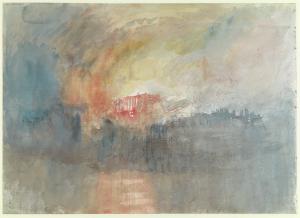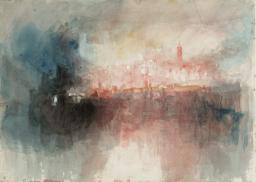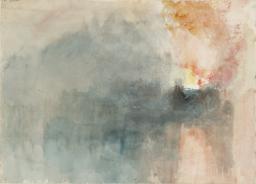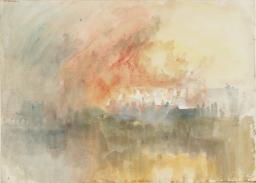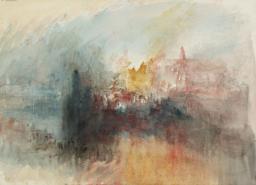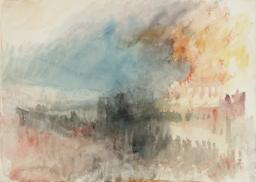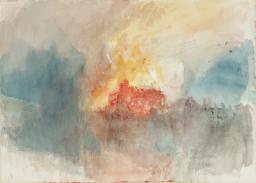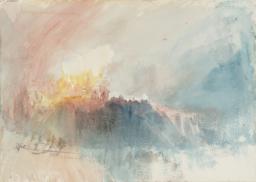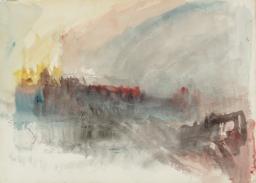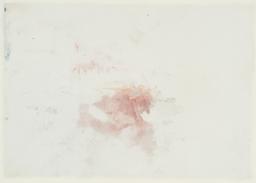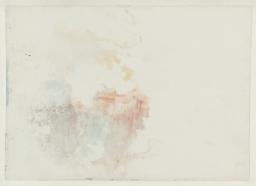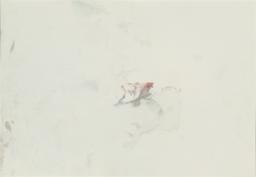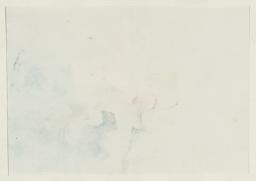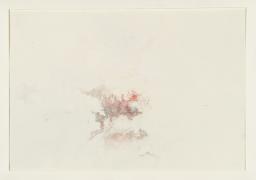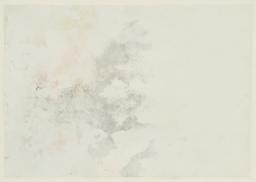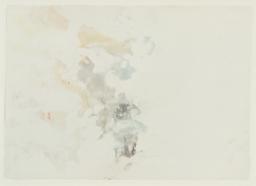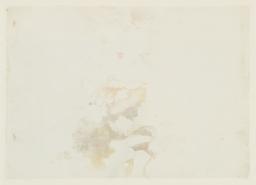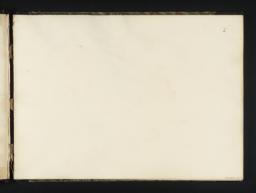Turner Bequest CCLXXXIII 1–32
Sketchbook, half-bound in boards with paper covers, marbled against a diagonally striped green background, over black leather spine and corners, with seven thin gold bands stamped on the spine
23 leaves and pastedowns of white wove paper; page size 235 x 325 mm; 9 further leaves extracted and mounted (see main catalogue text)
Inscribed in pencil in an unknown hand ‘7/ | 72’ inside front cover, top left
Numbered 70 as part of the Turner Schedule in 1854 and endorsed by the Executors of the Turner Bequest, John Prescott Knight and Charles Lock Eastlake in ink inside front cover ‘No 70’ and in pencil ‘JPK’ and ‘C.L.E’ inside front cover, bottom left, upside down
Inscribed in pencil ‘CCLXXXIII’ inside front cover, towards top left
Stamped in black ‘CCLXXXIII’ inside front cover, towards top left
Inscribed in pencil in an unknown hand ‘7 | 72’ inside back cover, bottom right, upside down
Inscribed in pencil in an unknown hand ‘66.132’ inside back cover, upside down
23 leaves and pastedowns of white wove paper; page size 235 x 325 mm; 9 further leaves extracted and mounted (see main catalogue text)
Inscribed in pencil in an unknown hand ‘7/ | 72’ inside front cover, top left
Numbered 70 as part of the Turner Schedule in 1854 and endorsed by the Executors of the Turner Bequest, John Prescott Knight and Charles Lock Eastlake in ink inside front cover ‘No 70’ and in pencil ‘JPK’ and ‘C.L.E’ inside front cover, bottom left, upside down
Inscribed in pencil ‘CCLXXXIII’ inside front cover, towards top left
Stamped in black ‘CCLXXXIII’ inside front cover, towards top left
Inscribed in pencil in an unknown hand ‘7 | 72’ inside back cover, bottom right, upside down
Inscribed in pencil in an unknown hand ‘66.132’ inside back cover, upside down
Accepted by the nation as part of the Turner Bequest 1856
References
Nine vivid, loosely worked watercolours formerly comprised consecutive leaves inside one of the covers of this otherwise blank sketchbook (D27846–D27854; Turner Bequest CCLXXXIII 1–9). They are all here newly identified as showing the destruction of the Grand Storehouse at the Tower of London by a fire which began on the evening of Saturday 30 October 1841, and continued to burn fiercely at times for several days. They were first documented by A.J. Finberg as ‘Burning of the Houses of Parliament’ subjects in the 1909 Turner Bequest Inventory;1 these identifications also prompted the overall name ‘Burning of the Houses of Parliament Sketch Book (1)’. The sketchbook has now been retitled to reflect its contents. Before the 1841 fire and Turner’s response are addressed, the very extensive literature addressing the watercolours as Houses of Parliament subjects necessitates a review of previous opinions and the ways the present works were thought to relate to the artist’s unambiguous treatments of the 1834 fire.
As Finberg succinctly noted in relation to the sketchbook: ‘The Houses of Parliament were burnt on October 16th, 1834, and the oil painting of this subject by Turner was exhibited at the R.A., 1835, and another version at the British Institution the same year.’2 The book was not labelled by Turner, so Finberg presumably made the identification on the grounds of the formal and colouristic similarities between its apparently nocturnal representations of a major fire at a complex of waterfront buildings, and Turner’s representations of the Palace of Westminster fire of 1834. On that occasion, the Houses of Lords and Commons were largely destroyed, leading to their rebuilding by Barry and Pugin in the form seen today beside the River Thames in central London. There are two major oil paintings, The Burning of the House of Lords and Commons, 16th October, 1834, exhibited at the British Institution in 1835 (Philadelphia Museum of Art),3 and The Burning of the Houses of Lords and Commons, October 16, 1834, exhibited at the Royal Academy in the same year (Cleveland Museum of Art, Ohio).4 There is also a slightly unfinished but wholly recognisable watercolour composition of the fire seen from Old Palace Yard (Tate D36235; Turner Bequest CCCLXIV 373)5 and a watercolour vignette of the scene framed by an arch of Westminster Bridge (Museum of Outdoor Arts, Englewood, Colorado),6 engraved for The Keepsake in 1836. Finberg also names a second sketchbook in relation to the event: the small book of slight pencil sketches traditionally known as the Burning of the Houses of Parliament (2) sketchbook (Tate; Turner Bequest CCLXXXIV); in all probability it does not relate to the 1834 fire either. It is possible that Turner’s only preparatory studies were actually the small architectural sketches which can be related to D36235, in the Fishing at the Weir sketchbook (Tate D27737, D27746–D27748; Turner Bequest CCLXXXI 7a, 12, 13, 13a).
Until now, all sources have followed Finberg’s 1834 Houses of Parliament identification, albeit sometimes expressing strong doubts about what exactly the watercolour studies show and the circumstances of their production.7 A longstanding tradition developed that they were likely to have been made ‘on the spot’ at or around the scene itself during the course of the fire,8 and the varieties of viewpoints and features have been explained with some ingenuity as owing to Turner’s movements up and down the Thames through the night.9 In his extended catalogue entry for the Philadelphia painting, Richard Dorment presented the most sustained interpretation of the nine studies in terms of a sequence reflecting the topography and chronology of the 1834 fire,10 while prefacing his discussion by noting reservations as to the Westminster identification.11 Others have suggested or implied that Turner’s known aversion to the difficulties of working outdoors with watercolours in general, let alone on such an occasion, at night, in uncertain light among large crowds, meant that they were probably made soon afterwards in the quiet of his London studio.12
The watercolours are in the loose exploratory mode of the so-called ‘colour beginnings’ (many of which are at Tate in Turner Bequest section CCLXIII; for example see those grouped as ‘England and Wales Colour Studies c.1826–39’ elsewhere in this catalogue),13 in which broad washes evoking light, atmosphere and the masses of architectural and landscape forms generally take precedence over precise detail. The lack of any clear correlation between Turner’s buildings and those at Westminster in the present watercolours has been noted,14 but justified by Gerald Wilkinson as symptomatic of Turner’s lack of concern with ‘documentary detail’:
They are variations on a primary theme, in which the perspective, the flaming structure and its reflection, the smoke and the darkness are interchanged: and the scene itself could be anywhere, at any time in history. In two of the sketches the buildings assume a rudimentary classical shape: in another it might be a great forge.15
By the early 1980s, Turner scholar Andrew Wilton was suggesting that the studies were either generalised meditations on the Parliament fire and the effects of fire and water at night, or that they might actively relate to quite other events as represented by Turner,16 such as the so-called Fire at Fennings Wharf, on the Thames at Bermondsey, of about 1836 (Whitworth Art Gallery, Manchester),17 which has subsequently been compared stylistically with the present works.18
In the 1960s, when Turner’s work was being explored as a sort of proto-Modernism, Lawrence Gowing described the Parliament theme, particularly in the Philadelphia version, as ‘like Romantic opera, with elaborate scenery and full chorus of horrified spectators’, while in the Cleveland version, ‘nearest to the sketchbook’ (that is to say the watercolours catalogued here as Tower of London views), ‘the play of fire and its reflection in water were sufficient subjects in themselves. He discovered a kind of equivalence between the experience and the picture for which his contemporaries were at a loss to account.’19 Referring in part to the watercolour studies, Jack Lindsay described how the ‘Parliament works allowed him to express to the full his liking for dramatic contrasts of warm and cold colours, the reds and oranges of the flapping flags of flame and the quiet blues of the sky; contrasts of the violent flame and the quietly flowing river – with the flame reflections, lurid or soft, as a connexion’20 (compare Celina Fox’s later description of the subjects ‘glowing scarlet at the heart of the yellow flames and reflected in the inky water’21). The artist and writer Adrian Stokes described Turner’s nine studies, regarded in formal terms, as ‘among his great masterpieces’.22
There has therefore never been doubt that the nine watercolour studies represent ‘vivid impressions of ... disaster’,23 but the previously the disaster in question has been inadvertently identified incorrectly by association with other Turner works. For the remainder of the present account, attention will refocus on events in London seven years after the Westminster fire.
On 22 October 1841, Turner wrote to the engraver William Miller: ‘My Dear Sir, So much time – for I only return’d from Switzerland last night – since your letter’.24 This marked the conclusion of the first of Turner’s four late annual Swiss tours. A week later, late on Saturday 30 October 1841, a major fire broke out at the Tower of London, the ancient fortress on the River Thames at the south-eastern boundary of the City. Having begun nearby in the medieval Bowyer Tower,25 the central tower of five along the wall on the north side of the complex above the moat and Outer Ward, the conflagration spread to the roof of the Grand Storehouse.26 North of the turreted central stone keep known as the White Tower, this substantial red-brick, stone-dressed building in the English Baroque style, comparable to some blocks at the Old Royal Naval College, Greenwich, and to the Royal Hospital Chelsea, was completed in 1692. On its two main floors it housed a historical collection of armaments in the Large and Small Armouries. Some 60,000 items were destroyed.27 An 1830 source noted that the second storey, with dormer windows set in the sloping roof, ‘called the Tent Room, was formerly used as a depository for camp equipage, but is now appropriated to the reception of military accoutrements, and stores of various descriptions.’28 The building was reduced to a shell, and the castellated medieval-style Waterloo Barracks, begun in 1845, now stand on the site.29 Ivan Lapper (born 1939) has painted informative bird’s-eye reconstructions of the Tower before, during and after the fire as part of a longer historical sequence (Historic Royal Palaces, Tower of London).
Before addressing the documentary and pictorial evidence of Turner’s involvement with the subject, it is worth quoting from the extensive newspaper accounts of the fire, with their many details of the scale and appearance of the event which would have appealed to the artist’s dramatic and visual senses. On Monday 1 November the Morning Chronicle reported at length:
The first discovery was made about half-past ten o’clock on Saturday night [30 October] by the sentry on duty at the Jewel-office, who perceived a bright light issuing from the windows [of the Bowyer Tower], which is situate at the northern extremity of the building, and immediately attached to the Grand Storehouse, or Armoury – a lofty brick edifice occupying the whole length of the inner square, and directly facing the White Tower. ... The flames ... gained a fearful ascendancy, and the fire had made its way from the Round Table [or Bowyer] Tower to the centre of the Grand Armoury, and bust forth from several windows with extraordinary fury, rapidly extending its consuming powers in both easterly and westerly directions. From the first moment of alarm the outer gates were very properly, by order of the governor, closed against the admission of the public ... The greatest possible difficulty, however, was experienced in obtaining a supply of water ...
In the Grand Armoury, which is stated to have been the largest room in Europe, being upwards of 350 feet long and 60 wide, were deposited 280,000 stands of arms, besides a vast quantity of military carriages, bombs, and other spoils of war ... The flames having once penetrated this hall, no hope existed that any portion of it would be saved, and the exertions of the firemen were confined to keeping the surrounding buildings a cool as possible, by playing all the water they could upon them. At this crisis the greatest apprehension was entertained for the safety of the Crown jewels deposited in the Regalia-office [in the Martin Tower] – which closely adjoins the eastern extremity of the grand Armoury – and the Yeomen of the Guard, under the direction of their captain, were deputed to undertake their removal. ...
Notwithstanding the lateness of the hour, the alarm soon spread through the metropolis, and Tower-hill and its immediate neighbourhood were densely thronged at this period of the conflagration. The atmosphere was illuminated in an extraordinary degree, and the fire might have been seen at many miles distance, while the reflection on the surrounding houses, and on the shipping on the river, produced a most striking effect. At about one o’clock the appearance of the burning mass was surpassingly grand, the flames having at that time extended to nearly the whole length of the grand Armoury; shortly after, the roof being completely burnt through, fell in with a tremendous crash, the flames rising with a lurid glare far above the lofty towers of the citadel. ... The fire was not subdued, however, until near five o’clock, and the mass of ruins was burning fiercely throughout the whole of yesterday.30
The same report noted that a fireman had been killed by falling masonry. A second item described the origins of ‘that splendid building’, the Grand Storehouse, ‘began by James II., finished by William III., and in which he and his consort Mary held princely revels’,31 and continued with more eye-witness details:
The fire now rapidly extended from the centre towards each wing of the building, bursting out of the windows, and blazing high into the air. Water was now plenty; the tide was high, and the two floating engines assisted to pour torrents upon the flaming masses, but in vain.
The whole of the grand storehouse was now wrapped in fire. The scene without the walls of the Tower was almost as wild as within. The gates were actually besieged, and the glare of the conflagration showed Tower-hill alive with multitudes gazing horror-struck upon the scene before them. Vague but fearful stories began to circulate among them of gunpowder stored in the Armoury ... and for many hours it was believed that in another moment the whole Tower might be blown to atoms. Fortunately ... no gunpowder was kept in the burning buildings.
The heat thrown from the flaming masses was now intense. ... The clock, now surrounded by fire, pealed its last chime, eleven, and shortly after the tower that contained it, the roof and floor, came crashing down with a shock as if of an earthquake ... The fire roared upwards, burst out at every cranny ... The melting metal communicated to it dyes of every hue, and it gleamed with a baleful light on the toiling men, and lit up the dark masses of buildings around with a wild and lurid glare. ...
A battalion of foot guards now arrived to aid the almost superhuman endeavours still made to get the fire under. A tremendous rush took place at the gates to get admission along with the military; as scene of terrible confusion and violence followed – the people were repulsed ... About two the fire began to abate, from lack of substance to feed on; and by three it might be said to have been got under. Nothing then remained but the shell of the vast building – all within was a heap of ruins, still burning fiercely. ... The engines continued to play upon the ruins, which emitted vast clouds of dull white smoke, occasionally reddened with a burst of fire, while ever and anon the masses of the still upstanding walls fell among the ruins, sending up brilliant masses of sparks. ... thousands crowded to the melancholy scene. ...
Admission to the fortress was given to none but those on business ...
Such was the state of the ruins up to six o’clock yesterday evening ... and as the night closed in, the glare from the mass of rubbish was very bright.32
Detailed accounts discussing the nine watercolours in terms of the 1834 fire and the immediate issues of the circumstances of their making raised in the remainder of this paragraph include Butlin and Joll 1984, p.208; Solender 1984, pp.43–[53], Dorment 1986, pp.398–401, Lyles 1992, pp.71–2 and Taft 2007, pp.179, 181.
For an eye-witness account of Turner’s presence see Solender 1984, p.42; see Clark and others 1959, p.224; Finberg 1961, p.350; Butlin 1962, p.50; Taylor 1964, p.44; Gowing 1966, p.33; Staley 1966, p.195; Reynolds 1969, p.[164]; Haftmann, Wilton and others 1972, p.113; Butlin 1975, p.11; Herrmann 1975a, p.41; Herrmann 1975b, p.69; Walker 1976, p.108; Hardy 1988, p.42; Upstone 1993, p.92; Joll 1996, p.94; Lloyd 1996, p.198; Fox 1999, p.13; Smiles 2001, p.206; Luke Herrmann, ‘Turner, Joseph Mallord William (1775–1851)’, Oxford Dictionary of National Biography, 2004 (online edition 2006), accessed 23 January 2014, http://www.oxforddnb.com/view/article/27854 ; Meslay 2004, pp.95–6; Siewart 2004, p.196; Wynne 2004, p.43; Meslay 2005, pp.95–6.
See Finberg 1961, p.350; Gaunt 1971, p.8; Gaunt and Hamlyn 1981, p.14; Gage 1983, p.125; Gaunt and Hamlyn 1984, p.13; Hamilton 2003, p.172; Ackroyd 2005, p.131.
Dorment 1986, pp.400–1, reproducing all the nine watercolour studies as figs.III-4–III-12 in this proposed sequence; this interpretation was noted, in advance of its publication, in Solender 1984, p.74 note 11; [Joll in] Butlin and Joll 1984, pp.208, 209, 215, and both Joll 1985, p.4 and Wilton 1985, p.54 in response to Solender, these authors having also seen Dorment’s text in draft; see also Lyles 1992, p.72, and Joll 1996, p.95, recapitulating Dorment.
See Gage 1969, pp.35, 231 note 91; Butlin, Wilton and Gage 1974, p.129; Wilkinson 1975, p.78; Hofmann 1976, p.163; Wilton 1977, p.66; Wilton 1979, pp.218, 227 note 79; Wilton 1985, p.54; Dorment 1986, p.398; Chumbley and Warrell 1989, p.37; Lyles 1992, p.72; Warrell 1993, pp.302–3; Warrell 1994, p.188; Egerton 1995, p.79; Powell 1995, p.56; Golding 1996, p.168; Bailey 1997, p.334; Brown 1997, p.280; Bower 1999, p.57; Smiles 2000, pp.44–5; Marlow, Grabsky and Rance 2001, p.308; Solender 2001, p.217; Wilton 2001, p.363; Brown 2002, p.145; Wilton 2006b, p.[145] note 14; Taft 2007, p.179; Smibert 2010, p.78; Warrell 2010, p.73; Richter-Musso 2011, pp.47, 183.
See also Eric Shanes, Turner’s Watercolour Explorations 1810–1842, exhibition catalogue, Tate Gallery, London 1997; and Wilkinson 1975, p.16, and Solender 1984, p.74 note 11.
See Wilton 1983, pp.278–9; Wilton 1985, p.54; and Wilton 2001, p.363; see also Solender 1984, p.74 note 13; Dorment 1986, p.398, concerning a 1982 discussion with Wilton on this topic; Lyles 1992, p.72; Brown 2002, p.145; the sketchbook remained linked to the 1834 fire by default in Wilton 1987, p.206, and Wilton 2006b, p.240.
Wilton 1979, p.359 no.523, reproduced; but for a revised identification see Ian Warrell, ‘J.M.W. Turner and the Pursuit of Fame’ in Warrell (ed.), Franklin Kelly and others, J.M.W. Turner, exhibition catalogue, National Gallery of Art, Washington 2007, p.19 fig.12 (colour), as ‘A Steamer at Adelaide Wharf, with London Bridge’.
Hartley 1984, p.55, and Nugent and Croal 1997, p.102, albeit noting that Turner was in Switzerland at the time of the Fennings Wharf fire.
John Gage, Collected Correspondence of J.M.W. Turner with an Early Diary and a Memoir by George Jones, Oxford 1980, p.184 letter no.246.
See ‘Office of the Ordnance’, Historic Royal Palaces: Tower of London, accessed 21 March 2014, http://www.hrp.org.uk/TowerOfLondon/stories/buildinghistory/office-of-the-ordnance .
See ‘19th century Tower’, ibid., accessed 20 March 2014, http://www.hrp.org.uk/TowerOfLondon/sightsandstories/buildinghistory/theTowerinthe19thcentury .
See ‘Office of the Ordnance’, ibid., accessed 21 March 2014, http://www.hrp.org.uk/TowerOfLondon/stories/buildinghistory/office-of-the-ordnance .
See ‘19th century Tower’, Historic Royal Palaces: Tower of London, accessed 20 March 2014, http://www.hrp.org.uk/TowerOfLondon/sightsandstories/buildinghistory/theTowerinthe19thcentury ; see also Lord Ronald Sutherland Gower, The Tower of London, London 1902, vol.II, pp.142– 5.
A third report vividly describes the crowds, weather and brilliant firelight:
From the commanding situation of the Armoury, which stands on the most elevated part of the Tower, a capital view was obtained from the neighbouring hills. Throughout the whole of yesterday ... At any one time throughout the day, as well as on the Saturday night, there could not have been fewer than fifty thousand persons. As the rain began to fall, and umbrellas were spread, it produced a novel and unique effect. ... It was as light as mid-day, and in the gardens at the back of the Old London-wall, the robins began to twitter, and to leave their nests as though daylight had dawned.33
On Wednesday 3 November, the Morning Chronicle brought the story up to date:
Throughout the whole of yesterday the same species of excitement which had prevailed in the vicinity of the Tower of London since the lamentable catastrophe of Saturday night, continued without the slightest abatement. The same precautionary measures which had been adopted, with reference to the admission of strangers previously, was still rigidly enforced by the warders, acting under the directions of Major Elrington, the governor, without whose order no one could be permitted to pass.
During the night of Sunday, the fire still raged with unabated fury within the walls of the Armoury ... Throughout the entire of yesterday morning they kept bursting forth at intervals to such an alarming extent ...
His Grace the Duke of Wellington, the constable, was fully expected to visit the fortress yesterday in company with Sir Robert Peel ...34
There were similarly detailed reports in the Times on 1 November, calling the fire an ‘event which will be long remembered in the annals of British history, and which may be regarded in every respect as a truly national calamity’.35 The extracts here omit some details covered in much the same way in the Morning Chronicle:
The conflagration, which exceeded in grandeur even the great fire at the House of Commons [1834] or the Royal Exchange [London, 1838], caused the greatest consternation throughout the entire metropolis, and from the commanding situation of Tower-hill, many thousand persons had an opportunity of witnessing the progress of the devouring element. ...
By 11 o’clock the destruction of the Round [Bowyer] Tower was complete, and for a short time great hopes existed that danger was at an end, but subsequently a cry was raised that it had reached the Armoury roof nearest adjoining it. ... flames were seen issuing from all parts of the roof of the building, and subsequently reaching to the Clock-tower in the centre. The flames, which shot up to a most alarming height, had so reddened the horizon that it had attracted to the neighbourhood of Tower-hill countless multitudes, and the lurid glare which the devastating element upon them and upon the various craft with which the river Thames was studded was picturesque and appalling in the extreme. ...
By half-past 12 o’clock the conflagration had reached to a frightful magnitude. ... Fire was to be seen gushing forth from every window of the building, which had all the appearance of the crater of some volcano. At 1 o’clock the whole of the Clock Tower, which had stood tottering for some time, together with a great mass of the roof ... fell in with a tremendous crash, resembling the firing of heavy artillery. Immediately after this, the flames for some time increased their height, but assumed a livid hue of a most unearthly description. ... The leaden water pipes, running from the roof of the [White Tower] were melted. ...
At 2 o’clock the fire was evidently at its greatest altitude, and a rumour spread ... that a large magazine was attached to the Armoury, and great fears were now entertained that a general explosion would take place. At times it appeared that such was really the case, for occasionally the flames would vomit forth burning embers of immense magnitude, again subside, and again repeat their dreadful thunders. This continued until about a quarter to 3 o’clock, when the fire showed some symptoms of abating its fury ... copious streams of water being poured into it from every direction, between 4 and 5 o’clock yesterday morning all danger of the flames spreading further had ceased. ... During the entire of yesterday the centre of the building presented one body of fire.36
There were follow-up reports on Tuesday 2 November:
From an early hour in the morning [after the outbreak], and indeed for the whole of Sunday night, Tower-hill and all the avenues leading thereto presented a most lively appearance. As night came on and gradually darkened, the outline of the shell of that once magnificent building, the Armoury, together with the Bowyer-tower, the news store-house, &c., became distinctly visible by the lurid glare of light playing upon the ruins, and produced from the immense pile of burning rubbish still smouldering and at times bursting forth in violent flames from within. ...
As [Monday] morning approached, the fire in the body of the building at intervals burst out in large masses of flame ...37
Further particulars of the initial outbreak were also reported, as discussed under D27847, which includes a visual detail which might relate to the newspaper account. Turner evidently applied rapidly for direct access to the Inner Ward of the Tower but, in line with the newspaper reports, was rebuffed by a terse note dated (Wednesday) 3 November from the Duke of Wellington, the Constable of the Tower since 1826:38
V M The Duke of Wellington presents his compliments to Mr Turner. The Comg. officer in the Tower has given orders that no person shall be admitted except on business.
It cannot be expected that the Duke should interfere with an order so given without responsibility for the consequences –
The Duke declines to take upon himself such responsibility.39
In compiling Turner’s correspondence, John Gage recognised the fire as the likely immediate occasion of this note, albeit without making a connection to any works by Turner, and provided some useful background details: ‘Nothing is known of the circumstances of Turner’s proposed visit to the Tower, which may, however have been to see the results of the great fire of 30 Oct. 1841 ... Other artists, including George Cruikshank [1792–1878], were allowed to visit and sketch the ruins on 6 Nov., and they were not finally closed to the public until 10 Nov.’40
There is an illustrated account of the fire and its aftermath in Cruikshank’s 1842 Omnibus.41 The London Metropolitan Archives hold rather sedate prints by William Oliver (1804–1853; see also below) showing well-dressed visitors in the Inner Ward and inside the shell of the Grand Storehouse in a series of Six Views Taken after the Great Fire at the Tower of London, 31 October 1841, as well as a comparable View of the Ruins of the Grand Storehouse in the Tower of London, Comprising the Train of Artillery and Small Armoury, as They Appeared after the Fire of October 30th 1841, a lithograph after Edward Falkener (1814–1896). Gage noted that short shrift from the eminent, ageing and no doubt still extremely busy Wellington was not unusual in such instances;42 in the wider setting of London’s high society, the Duke and Turner were said, probably somewhat optimistically, to be friends by one uncorroborated slight acquaintance of the artist.43
Much of the evidence that Turner’s nine watercolour studies represent the Grand Storehouse fire at the Tower lies in visual comparison with contemporary prints mentioned below, showing the fierce flames bursting through rows of tall windows and the roof with its central cupola, beyond the dark outer bastions, low pitched-roofed buildings in the Outer Ward, and the perimeter walls and towers; at times the White Tower appears to be indicated or hinted at, particularly in D27847. In the prints, large crowds are seen watching from across the broad moat (drained in 184544 and now a lawn), which ran round the roughly square complex on the three sides away from the River Thames; Turner seems to show figures in some of his foregrounds. Along the west side ran Petty Wales and Great Tower Hill (now pedestrianised). To the north, Great Tower Hill continued between Trinity Square and the moat, separated from Little Tower Hill by buildings along Postern Row (no longer extant), directly opposite the Grand Storehouse; all of this side is now simply ‘Tower Hill’. Little Tower Hill, now Tower Bridge Approach, continued south towards the river, with warehouses on the perimeter of St Katharine Docks, running parallel with the moat. These surroundings are now much changed in terms of their buildings, landscaping and modern traffic schemes, and the towers along the north side of the complex have been regularised. However, it is still possible to recognise that the various juxtapositions of architectural features beyond water, and the sense of different viewpoints and water surrounding the conflagration in Turner’s studies can be accounted for by his movement around the streets and open spaces on these three sides, albeit always focusing on the seat of the fire.
In technical terms, the frequently rehearsed arguments noted in connection with the 1834 Parliament fire, as to whether Turner made the nine watercolour studies on the spot in the course of the event, remain unresolved in the context of 1841. It is possible, but perhaps very unlikely. To have witnessed the collapse of the roof and clock tower of the Grand Storehouse, features which seem to be indicated in some of his studies, he would have had to travel across London to join the throng before one o’clock on the Sunday morning after the alarm had been raised barely two hours earlier. He could have visited the scene in the course of the week while the fire still raged at times, and either witnessed some of the effects he shows or imagined them at their height.
Another factor is the publication within a very few days of topical prints of the fire; impressions are held in the London Metropolitan Archives. Just as certain popular images can be compared with Turner’s views of the Westminster fire, so some of those produced in November 1841 have points in common in their composition, colour and effect with Turner’s ‘colour beginnings’ of the Tower, and it is possible that they might have influenced him directly or indirectly. (In turn, it is interesting to consider to what extent the other artists were influenced by Turner’s own earlier depictions of fire and disaster.) Destruction of the Small Armoury in the Tower of London, on the Night of 30th Oct., 1841, a colour lithograph after William Collingwood Smith (1815–1887) published on 8 November, is one of the most accomplished, and its composition, with the Grand Storehouse seen obliquely from the north-west with its many windows illuminated by fire within, can be compared with that of D27846. Destructive Fire at the Tower of London. October 30th 1841, a colour lithograph after J.L. Marks, is a more graphic, unsophisticated rendering of the same view. The Armoury as Seen from the Interior of the Garrison from the Parade after the Falling In of the Roof and The Conflagration as Seen from Tower Hill before the Destruction of the Roof of the Armoury, two colour lithographs by G.F. Bragg on one sheet with the overall title Destruction of the Armoury in the Tower of London by Fire, on Saturday Night, October 30th 1841 show views from inside the Inner Ward and from beyond the moat respectively, the latter from the north-west as in Smith’s lithograph.
Conflagration of the Tower of London, on the Night of the 30th of October 1841, a colour lithograph published on 3 November of a view ‘drawn upon the spot by William Oliver’ shows the Tower complex from the north, with flames and smoke pouring from the windows and rafters of the Grand Storehouse, can be compared with D27847, Turner’s watercolour with the most precisely detailed architectural features. View of the North Side of the Tower of London: Shewing the Extent of the Armoury, Jewels’ Tower &c as Consumed by Fire on the Night of Saturday, Oct. 30, 1841, a colour lithograph after Thomas Colman Dibdin (1810–1893), shows the ascending spatial sequence from the moat to the White Tower, based on a pencil drawing and a watercolour apparently made after the fire was out (both London Metropolitan Archives). It is comparable to several of Turner’s studies. The Tower of London, as it Appeared after the Conflagration, Oct 30, 1841, an annotated pencil study from the same side by Thomas Hosmer Shepherd (1793–1864) is in the same collection.
The most distinguished artist to respond publicly was the watercolourist Thomas Shotter Boys (1803–1874). His colour lithograph, The Tower of London, as Seen October 31st 1841, the Morning after the Fire, was published on 5 November, and is subdued in effect, showing wispy white smoke against a pale morning sky. By contrast there is the luridly coloured, childlike colour print of the View of the Awful Conflagration at the Tower of London, and Immense Loss of National Property. October 31st. 1841, ‘from the drawing taken on the spot by an eminent artist’ for a broadsheet sold by the bookseller John Butler Fairburn of the Minories, just north of the Tower. Similarly naïve are the monochrome woodcut front cover illustrations of the Destructive Fire in the Tower of London in The Penny Sunday Chronicle and People’s Weekly Advertizer of 14 November, and The Awful Fire at the Tower of London in Clark’s Weekly Dispatch of the same date. Perhaps surprisingly, there is only one painting of the fire in a British public collection, a small anonymous panel depicting the event to the north from across the Thames in a conventional style (Royal Armouries at the Tower of London). Conflagration at the Tower of London of 1841, a watercolour by John Christian Schetky (1778–1874) shows a similar view (Courtauld Gallery, London).
Lawrence Gowing has observed how in Turner’s later years the ‘classical sequence of tones was increasingly replaced by interactions of colour’,45 and Graham Reynolds noted that ‘he was more and more liberated in his attitude to colour of the highest pitch.’46 Aside from their being signifiers of fire47 and its setting, the reds, yellows and blues used here (see the Technical notes) sit well with Turner’s relatively unmodulated use of these colours together with black or dark grey accents against the bare white of the paper in the ethereal watercolours sketches made on the Swiss tours of the early 1840s. Examples from the first tour, immediately preceding the Tower of London fire are, from the Fribourg, Lausanne and Geneva sketchbook, Tate D33474, D33479, D33481, D33483, D33487, D33489 and D33503 (Turner Bequest CCCXXXII 5, 9, 11, 13, 17, 19, 33) and, from the Lausanne sketchbook, Tate D33526, D33659 and D33661 (Turner Bequest CCCXXXIV 2, 7, 9).
John Gage linked other brightly coloured watercolour studies (Tate D27562, D27566, D27596, D27600; Turner Bequest CCLXXX 45, 49, 79, 83) directly to the Parliament fire theme,48 but of these the first two have since been identified as for literary subjects, and the others await detailed investigation. Turner certainly had a long-standing interest in the pictorial possibilities of fire, beginning with the aftermath of the Pantheon conflagration in London’s Oxford Street in 1792 (see Tate D00121; Turner Bequest IX A). Jack Lindsay has compared a number of ‘scenes in which fire appeared destructively or ominously’,49 particularly the large painting currently called A Disaster at Sea of about 1835 (formerly ‘Fire at Sea’; Tate N00558),50 and two watercolours in the Whitworth Art Gallery, Manchester: the so-called Fire at Fennings Wharf already mentioned, and A Conflagration, Regensburg (previously ‘Lausanne’), both of around 1836.51
Turner’s interest in the Tower as a subject extended back nearly fifty years before 1841. A small watercolour of about 1794 (Manton Collection of British Art, Sterling and Francine Clark Art Institute, Williamstown, Massachusetts, together with a slight pencil sketch)52 was engraved as The Tower of London for the Lady’s Pocket Magazine in 1795 (Tate impression: T05905). The view is north-west from the Thames, with the White Tower at the centre and what may be the Grand Storehouse’s clock tower obscured by rigging on the left. There is a slight drawing from the same direction in the River and Margate sketchbook of the late 1800s (Tate D06478; Turner Bequest XCIX 68a). Others are in the early 1820s River sketchbook (Tate D17810, D17811, D17819, D17821; CCIV 29a, 30, 34, 35) and Old London Bridge sketchbook (Tate D17857; Turner Bequest CCV 12a) and in the Tabley No.3 sketchbook, also in use in the 1820s (Tate D07062, D07064; Turner Bequest CV 56, 57). A watercolour (private collection)53 was engraved as The Tower of London for The Literary Souvenir in 1831 (Tate impression: T06137). There is a watercolour study of about 1830–2 (Tate D27610; Turner Bequest CCLXXX 93) for the vignette Traitor’s Gate, Tower of London (Tate D27694; Turner Bequest CCLXXX 177),54 engraved for Samuel Rogers’s 1834 Poems (Tate impressions: T05116, T06166). There is also a historical subject, the painting Lucy, Countess of Carlisle, and Dorothy Percy’s Visit to their Father Lord Percy, when under Attainder upon the Supposition of his being concerned in the Gunpowder Plot, exhibited in 1831 (Tate N00515),55 which shows an interior including a painting of the Tower hanging on the wall. Why Turner did not develop the 1841 fire as a finished watercolour or painting remains a matter for speculation: possibly he felt the result might be too similar to his 1834 paintings, or perhaps he was too absorbed by his recent Swiss travels.
The author is particularly grateful to Andrew Wilton and Tate Conservation Scientist Joyce Townsend for the informal technical examination of some of these watercolours at the Tate Britain Prints and Drawings Room on 26 November 2013; this was the occasion of his impromptu investigation and identification of the Tower of London fire as a possible subject in the course of the discussion. The meeting had been prompted by the Kurt Pantzer Memorial Lecture on ‘The Burning of the Houses of Parliament’ delivered to the Turner Society in London on 24 April 2013 by the art historian Julia Beaumont-Jones, Director of the Parliamentary Archives Caroline Shenton and Joyce Townsend. Andrew Wilton also generously provided the author with the opportunity of presenting the new identifications to a receptive audience at the annual general meeting of the Turner Society at the Paul Mellon Centre, London, on 7 December 2013, as an unexpected coda to the April event.
‘The Tower of London. Destructive Conflagration. (Additional Particulars.)’, The Times, Tuesday 2 November 1841, p.5.
See ‘Duke of Wellington’, Historic Royal Palaces: Tower of London, accessed 20 March 2014, http://www.hrp.org.uk/TowerOfLondon/stories/palacepeople/DukeofWellington .
Ibid.; for Turner and Wellington generally, see Nicholas Alfrey, ‘Turner and the Cult of Heroes’, Turner Studies, vol.8, no.2, Winter 1988, pp.33–8; John McCoubrey, ‘The Hero of a Hundred Fights: Turner, Schiller and Wellington’, Turner Studies, vol.10, no.2, Winter 1990, pp.7–11; and Luke Herrmann, ‘Wellington, Arthur Wellesley, Duke of (1769–1852)’ in Joll, Butlin and Herrmann 2001, p.375.
The American artist William J. Stillman in an article reprinted in Robert K. Wallace, ‘Reminiscences of Turner, from The Literary World, 1852’, Turner Studies, vol.9, no.2, Winter 1989, p.49.
See ‘19th century Tower’, Historic Royal Palaces: Tower of London, accessed 20 March 2014, http://www.hrp.org.uk/TowerOfLondon/sightsandstories/buildinghistory/theTowerinthe19thcentury .
Technical notes
How to cite
Matthew Imms, ‘Fire at the Tower of London Sketchbook 1841’, sketchbook, April 2014, in David Blayney Brown (ed.), J.M.W. Turner: Sketchbooks, Drawings and Watercolours, Tate Research Publication, September 2014, https://www

